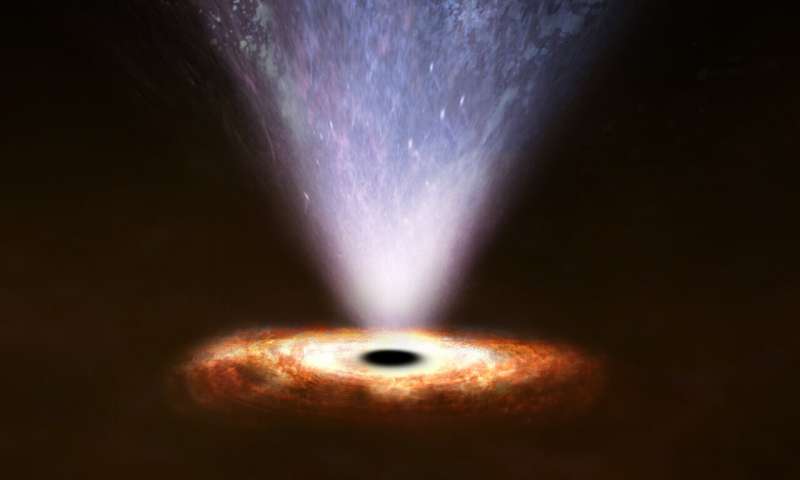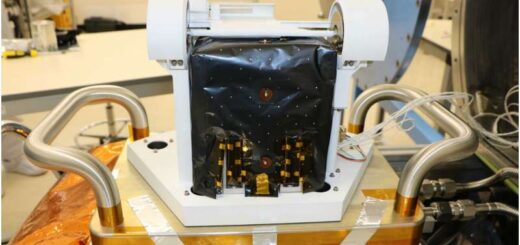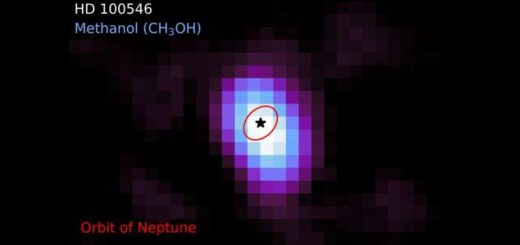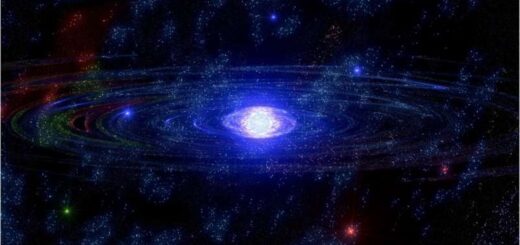How black holes shape galaxies

Data from ESA’s XMM-Newton X-ray observatory has revealed how supermassive black holes shape their host galaxies with powerful winds that sweep away interstellar matter.
In a new study, scientists analysed eight years of XMM-Newton observations of the black hole at the core of an active galaxy known as PG 1114+445, showing how ultrafast winds—outflows of gas emitted from the accretion disk very close to the black hole—interact with the interstellar matter in central parts of the galaxy. These outflows have been spotted before but the new study clearly identifies, for the first time, three phases of their interaction with the host galaxy.
“These winds might explain some surprising correlations that scientists have known about for years but couldn’t explain,” said lead author Roberto Serafinelli of the National Institute of Astrophysics in Milan, Italy, who conducted most of the work as part of his Ph.D. at University of Rome Tor Vergata.
“For example, we see a correlation between the masses of supermassive black holes and the velocity dispersion of stars in the inner parts of their host galaxies. But there is no way this could be due to the gravitational effect of the black hole. Our study for the first time shows how these black hole winds impact the galaxy on a larger scale, possibly providing the missing link.”
Astronomers have previously detected two types of outflows in the X-ray spectra emitted by the active galactic nuclei, the dense central regions of galaxies known to contain supermassive black holes. The so-called ultra-fast outflows (UFOs), made of highly ionised gas, travel at speeds up to 40 percent the speed of light and are observable in the vicinity of the central black hole.
Slower outflows, referred to as warm absorbers, travel at much lower speeds of hundreds of km/s and have similar physical characteristics—such as particle density and ionisation—to the surrounding interstellar matter. These slower outflows are more likely to be detected at greater distances from the galaxy centres.
In the new study, the scientists describe a third type of outflow that combines characteristics of the previous two: the speed of a UFO and the physical properties of a warm absorber.
“We believe that this is the point when the UFO touches the interstellar matter and sweeps it away like a snowplough,” said Serafinelli. “We call this an ‘entrained ultra-fast outflow’ because the UFO at this stage is penetrating the interstellar matter. It’s similar to wind pushing boats in the sea.”
This entraining happens at a distance of tens to hundreds light years away from the black hole. The UFO gradually pushes the interstellar matter away from the central parts of the galaxy, clearing it from gas and slowing down the accretion of matter around the supermassive black hole.
While models have predicted this type of interaction before, the current study is the first to present actual observations of the three phases.
“In the XMM-Newton data, we can see material at larger distances from the centre of the galaxy that hasn’t been disturbed yet by the inner UFO,” said co-author Francesco Tombesi of University of Rome Tor Vergata and NASA’s Goddard Space Flight Center. “We can also see clouds closer to the black hole, near the core of the galaxy, where the UFO has started interacting with the interstellar matter.”
This first interaction happens many years after the UFO has left the black hole. But the energy of the UFO enables the relatively small black hole to impact material far beyond the reach of its gravitational force.
According to the scientists, supermassive black holes transfer their energy into the surrounding environment through these outflows and gradually clear the central regions of the galaxy from gas, which could then halt star formation. In fact, galaxies today produce stars far less frequently than they used to in the early stages of their evolution.
“This is the sixth time these outflows have been detected,” said Serafinelli. “It’s all very new science. These phases of the outflow have previously been observed separately but the connection between them wasn’t clear up until now.”
XMM-Newton’s unprecedented energy resolution was key to differentiating between the three types of features corresponding to the three types of outflows. In the future, with new and more powerful observatories such as ESA’s Advanced Telescope for High ENergy Astrophysics, Athena, astronomers will be able to observe hundreds of thousands of supermassive black holes, detecting such outflows more easily. Athena, which will be more than 100 times more sensitive than XMM-Newton, is scheduled for launch in the early 2030s.
“Finding one source is great but knowing that this phenomenon is common in the Universe would be a real breakthrough,” said Norbert Schartel, XMM-Newton project scientist at ESA. “Even with XMM-Newton, we might be able to find more such sources in the next decade.”
More data in the future will help unravel the complex interactions between the supermassive black holes and their host galaxies in detail and explain the decrease in star formation that astronomers observe to have taken place over billions of years.



 Creators of mankind
Creators of mankind Description of “Tall white aliens”
Description of “Tall white aliens” Where they came from?
Where they came from? About hostile civilizations
About hostile civilizations The war for the Earth
The war for the Earth “Tall white aliens” about eternal life
“Tall white aliens” about eternal life Video: “Nordic aliens”
Video: “Nordic aliens” Aliens
Aliens Alien encounters
Alien encounters The aliens base
The aliens base UFO
UFO Technology UFO
Technology UFO Underground civilization
Underground civilization Ancient alien artifacts
Ancient alien artifacts Military and UFO
Military and UFO Mysteries and hypotheses
Mysteries and hypotheses Scientific facts
Scientific facts


















